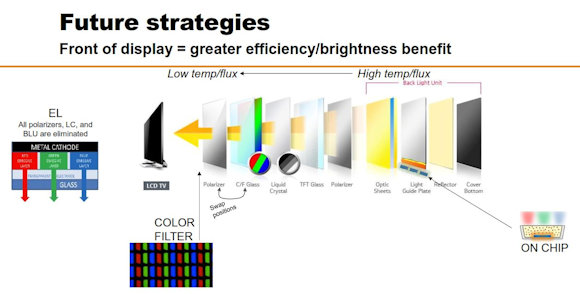Introduction
Samsung has been at the forefront of innovation in the world of display technology for decades. From pioneering OLED displays to exploring new frontiers in display technology, the company’s contributions have had a profound impact on the way we experience visual content. This article delves into Samsung’s significant role in advancing display technology, with a focus on OLED (Organic Light Emitting Diode) displays and what lies ahead.
One of the defining moments in Samsung’s history was its breakthrough in OLED (Organic Light Emitting Diode) technology. This marked a significant leap forward in the world of displays. OLED displays are known for their ability to deliver stunning visuals with deep blacks and vibrant colors, thanks to each pixel emitting its own light. This technology not only revolutionized the television industry but also made its way into smartphones, tablets, and wearables, offering users a visually immersive experience.
Samsung’s dedication to OLED technology didn’t stop at just producing displays; the company continued to innovate and push the boundaries. They introduced flexible OLED displays, allowing for curved and foldable screens. This innovation not only enhanced the aesthetic appeal of devices but also opened up new possibilities for design and functionality.
Furthermore, Samsung’s investment in research and development led to advancements like Quantum Dot OLED, which combines the vibrant colors of Quantum Dot technology with the self-emissive nature of OLED displays. This promises even more stunning visuals and energy efficiency.
As we look to the future, Samsung’s commitment to display technology remains unwavering. The company is actively researching MicroLED displays, which have the potential to deliver the benefits of OLED with improved longevity and brightness. With each step forward, Samsung continues to redefine the visual experience and set new standards in the world of displays. Whether it’s for entertainment, work, or everyday use, Samsung’s display innovations have a profound impact on how we interact with the digital world.
For a comprehensive look at this subject, we invite you to read more on this dedicated page: Next Generation TV Display Trends From CES 2023 – Display Daily
The Evolution of OLED Displays
OLED technology represents a significant leap in display quality compared to traditional LCD screens. Samsung’s exploration of OLED technology began in the early 2000s, with the introduction of OLED screens in smaller devices like mobile phones and digital cameras. OLED displays offer several advantages over LCDs, including:
Samsung’s journey into the realm of OLED technology has been marked by a commitment to innovation and a relentless pursuit of display excellence. It all started in the early 2000s when Samsung first ventured into the world of Organic Light-Emitting Diode (OLED) screens. Initially, these revolutionary displays found their place in smaller devices like mobile phones and digital cameras, but their potential for transforming the entire display industry was already evident.
One of the standout advantages of OLED technology is its ability to achieve true black levels. Unlike LCDs that rely on a backlight, each pixel in an OLED display emits its own light. When a pixel is turned off, it produces true black, resulting in infinite contrast ratios. This feature not only enhances the vibrancy of colors but also contributes to deeper, more immersive viewing experiences.
Furthermore, OLED displays are known for their exceptional color accuracy and wide color gamuts. They can reproduce a vast spectrum of colors with precision, making them ideal for applications where color fidelity is critical, such as professional photography and filmmaking. Whether you’re editing photos or enjoying a movie, OLED’s color accuracy ensures that what you see on the screen is a faithful representation of the original content.
OLED technology also enables thinner and more flexible displays. Since OLED screens don’t require a separate backlight, they can be significantly thinner than their LCD counterparts. This thinness not only contributes to the sleek and modern design of devices but also opens the door to innovative form factors, like foldable and rollable displays. Samsung’s exploration of flexible OLEDs has led to the development of cutting-edge devices that can adapt to different usage scenarios.
In addition to these advantages, OLED displays are known for their fast response times and low power consumption. This combination of qualities makes them ideal for applications like gaming and mobile devices, where smooth motion and efficient power usage are paramount.
As Samsung continues to push the boundaries of OLED technology, we can expect to see even more groundbreaking innovations in the world of displays. Whether it’s in the form of foldable smartphones, vibrant television screens, or other exciting applications, Samsung’s commitment to OLED technology is shaping the future of visual experiences.
For a comprehensive look at this subject, we invite you to read more on this dedicated page: After three decades, OLED technology continues to evolve …

Vibrant Colors
Each pixel in an OLED display emits its light, allowing for true blacks and vibrant colors. This results in stunning contrast ratios and more lifelike visuals.
OLED displays are a technological marvel in the world of visual technology. Unlike traditional LCDs, where a backlight is required to illuminate the pixels, OLED (Organic Light-Emitting Diode) displays work differently. In OLED displays, each individual pixel emits its own light when an electric current is applied. This fundamental difference has far-reaching implications for the quality of the display and how we experience images and videos on our screens.
One of the most significant advantages of OLED displays is their ability to achieve true blacks. When a pixel is turned off in an OLED screen, it doesn’t emit any light. As a result, you get a perfect black, as opposed to LCDs, where the backlight is always on, even when displaying black content. This difference in black levels translates into an infinite contrast ratio, making OLED screens capable of displaying the deepest blacks and the brightest whites within the same frame.
The implications of this are profound for visual quality. When you watch a movie or play a video game on an OLED screen, you get to experience every nuance of the content, from the darkest shadows to the brightest highlights. This level of contrast adds depth and realism to images, making them look more three-dimensional.
Moreover, OLED displays deliver more vibrant and accurate colors. Since each pixel emits its own light, they can be turned on and off individually. This precise control over each pixel allows OLED screens to reproduce colors with incredible accuracy. You get a wider color gamut, which means that OLED displays can reproduce a broader range of colors compared to LCDs. This results in more lifelike and true-to-life colors, making OLED displays ideal for tasks that demand color accuracy, such as photo and video editing.
Additionally, OLED screens have faster response times than traditional LCDs. This is because there’s no need for a backlight to change its brightness or turn on or off. When an OLED pixel receives an electrical signal, it can change its state almost instantly. This fast response time is especially important for gaming, as it reduces motion blur and ghosting, resulting in smoother and more immersive gameplay.
In summary, the ability of OLED displays to emit their own light on a pixel-by-pixel basis leads to several key advantages, including true blacks, infinite contrast ratios, more vibrant colors, and faster response times. These qualities collectively contribute to a superior visual experience, whether you’re watching your favorite movie, editing photos, or playing video games.
For a comprehensive look at this subject, we invite you to read more on this dedicated page: Future VR could employ new ultrahigh-res display | Stanford News

Flexibility
OLED displays can be made flexible and even foldable, paving the way for innovative form factors in smartphones and beyond.
Samsung’s contributions to OLED technology have not only made displays flexible and foldable but have also opened doors to entirely new possibilities in the world of electronics. These advancements have led to the creation of devices with curved and wraparound screens, allowing for immersive viewing experiences. Additionally, OLED technology has found its way into televisions, delivering stunning picture quality with vibrant colors and deep blacks. Samsung’s role in advancing OLED displays has undoubtedly shaped the future of visual technology.
For additional details, consider exploring the related content available here [10 Year Anniversary] A Decade of Samsung Display’s Historic …

Faster Response Times
OLEDs have faster response times, reducing motion blur in fast-paced content like videos and games.
Samsung’s commitment to OLED technology didn’t stop at smaller screens. In 2013, the company introduced OLED TVs, bringing the benefits of OLED to larger displays. These TVs garnered acclaim for their picture quality, earning Samsung a prominent position in the premium TV market.
Samsung’s venture into OLED technology extended beyond the realm of smaller screens, marking a significant milestone in the world of television. In 2013, the company made a bold move by introducing OLED TVs, bringing the exceptional benefits of OLED to larger displays. This marked a transformative moment in the television industry, as it offered consumers an entirely new level of visual quality and immersion.
OLED TVs quickly gained recognition for their breathtaking picture quality, characterized by perfect blacks, vibrant colors, and an infinite contrast ratio. The ability of OLED pixels to emit their own light individually meant that each pixel could be turned on or off independently, resulting in superior control over brightness and darkness. This not only delivered an unmatched viewing experience but also eliminated the backlight bleed issues often associated with traditional LCD TVs.
Samsung’s OLED TVs rapidly earned acclaim from both critics and consumers, establishing the company as a prominent player in the premium TV market. These televisions became synonymous with cinematic experiences in the comfort of one’s home, making them highly sought after by enthusiasts and discerning viewers.
The introduction of OLED TVs by Samsung not only solidified the company’s position as a leader in display technology but also elevated the expectations for television quality across the industry. Samsung’s commitment to pushing the boundaries of visual excellence continued to reshape the television landscape, setting new standards for what consumers could expect from their home entertainment.
Don’t stop here; you can continue your exploration by following this link for more details: ProArt Studiobook 16 3D OLED (H7604)|Laptops For Creators …

Beyond OLED: The Future of Display Technology
While OLED displays have already revolutionized visual experiences, Samsung is not resting on its laurels. The company is actively exploring new frontiers in display technology.
Samsung’s pursuit of display excellence doesn’t end with the groundbreaking innovations brought by OLED technology. Instead, it’s a relentless journey that continues to push the boundaries of what’s possible in visual experiences. As one of the leading pioneers in the display industry, Samsung is actively exploring new frontiers in display technology, paving the way for even more exciting advancements.
One of the avenues Samsung is diligently pursuing is the development of microLED displays. MicroLED is a promising technology that combines the best of both worlds—OLED and traditional LED. Like OLED, microLED displays offer self-emissive pixels, meaning each pixel emits its own light, leading to true blacks and infinite contrast ratios. This technology delivers the stunning contrast and color accuracy that users have come to expect from OLED displays.
What sets microLED apart is its potential for scalability and durability. Samsung envisions microLED displays being used in a variety of applications, from large-format TVs to small-scale screens for wearables. These displays are not only known for their exceptional picture quality but also for their longevity. MicroLEDs have a longer lifespan compared to OLEDs, ensuring that your display remains vibrant and reliable for years to come.
Samsung’s exploration of microLED technology extends to the development of “The Wall,” a modular microLED TV. With “The Wall,” users can create a custom-sized TV by combining individual microLED panels. This groundbreaking approach not only offers unparalleled flexibility in terms of display size but also positions microLED as a game-changer in the world of home entertainment.
Another frontier Samsung is actively exploring is foldable and rollable displays. With the introduction of foldable smartphones like the Galaxy Z Fold series and rollable display concepts, Samsung is redefining how we interact with devices. These innovative form factors offer the convenience of a compact device that can seamlessly transform into a larger screen for enhanced productivity and entertainment.
Moreover, Samsung’s research and development efforts are focused on improving energy efficiency and sustainability in display technology. The company is investing in next-generation materials and manufacturing processes to reduce the environmental impact of displays while maintaining high performance.
In conclusion, Samsung’s commitment to display technology is an ongoing journey of innovation and exploration. From OLED displays that have already revolutionized visual experiences to the exciting potential of microLEDs, foldable and rollable displays, and sustainable practices, Samsung’s vision is to shape the future of how we see and interact with the world around us. As consumers, we can look forward to even more remarkable advancements in display technology that will continue to redefine our digital lives.
Don’t stop here; you can continue your exploration by following this link for more details: QLED vs. OLED: What’s the Difference and Which TV Is Better …
MicroLED
Samsung is pioneering MicroLED displays, which offer the same benefits as OLED but with increased longevity. MicroLEDs use tiny, self-emitting LEDs, similar to OLEDs, but with the added advantage of reduced burn-in risk and longer lifespan.
While OLED displays have taken the tech world by storm with their stunning visuals and self-emissive pixel technology, they do come with some concerns, notably regarding burn-in. Burn-in occurs when a static image remains on the screen for an extended period, causing some pixels to degrade and leading to permanent image retention. This has been a drawback of OLED technology, especially for users who leave static elements like logos or menu bars on their screens for extended periods.
Samsung, always at the forefront of display technology, recognized this issue and sought to address it with MicroLED displays. MicroLEDs are tiny, self-emitting LEDs, much like the individual pixels in OLED displays. However, they have several advantages, one of which is their significantly reduced risk of burn-in.
The reason for this reduced burn-in risk lies in the construction of MicroLED displays. In OLED screens, each pixel consists of an organic material that emits light when an electric current passes through it. Over time, this organic material can degrade, leading to differences in brightness and color among pixels, causing burn-in. In contrast, MicroLEDs are inorganic and don’t degrade in the same way. They are essentially tiny individual light sources that emit light when needed. This fundamental difference in construction makes MicroLEDs highly resistant to burn-in, even when static images are displayed for extended periods.
Moreover, MicroLED displays offer another significant advantage: longevity. Since they don’t suffer from the same degradation issues as OLEDs, MicroLED screens have a longer lifespan. This is a critical consideration for users who want their displays to last for many years without experiencing any noticeable decline in performance or image quality.
Samsung’s pioneering work with MicroLED displays combines the best aspects of OLED, such as self-emissive pixels for stunning visuals, with the added benefits of reduced burn-in risk and increased longevity. This innovation opens up exciting possibilities for the future of display technology, promising even more exceptional visual experiences with fewer drawbacks. As MicroLED technology continues to evolve and become more accessible, it may well become the go-to choice for those seeking the ultimate in display quality and durability.
For additional details, consider exploring the related content available here Display Week > 2023 > Program > Short Courses
Quantum Dot Technology
Samsung’s QLED (Quantum Dot Light Emitting Diode) displays combine Quantum Dot technology with LED backlighting, resulting in exceptional color accuracy and brightness. This innovation has been integrated into both TVs and computer monitors.
Furthermore, Samsung’s QLED displays have been instrumental in enhancing the visual experience not only in the realm of televisions but also in computer monitors. The application of QLED technology in monitors has allowed professionals, gamers, and everyday users to enjoy stunningly vivid visuals and accurate color representation on their desktop screens. Whether you’re immersed in a cinematic masterpiece or fine-tuning intricate design work, Samsung’s QLED displays offer a level of quality and precision that sets the standard for visual excellence in various digital domains.
Additionally, you can find further information on this topic by visiting this page: Samsung Advances New Era of Screens With Its New 2023 Neo …

Stretchable Displays
Samsung is also working on stretchable displays, which could have applications in wearables and IoT devices, offering versatility and durability.
In addition to its groundbreaking innovations in OLED technology, Samsung is actively exploring the realm of stretchable displays. These displays represent the next frontier in visual technology, with the potential to revolutionize a wide range of industries, from wearables to IoT (Internet of Things) devices.
Stretchable displays, as the name suggests, possess a unique ability to stretch and flex without compromising their functionality or image quality. This flexibility opens up a world of possibilities for their application. In the realm of wearables, such as smartwatches and fitness trackers, stretchable displays can conform to the contours of the wearer’s wrist, providing a more comfortable and ergonomic fit. This not only enhances wearability but also offers new opportunities for creative and innovative designs in the fashion tech space.
Moreover, IoT devices can benefit immensely from stretchable displays. These displays can be seamlessly integrated into various IoT products, from smart home appliances to healthcare devices. For instance, a stretchable display on a smart refrigerator could adapt to different surface shapes, allowing for dynamic content and information presentation. In the healthcare sector, IoT devices like health monitors or wearable patches with stretchable displays could comfortably adhere to the body while continuously providing valuable data to users.
Versatility and durability are key attributes of stretchable displays. By being able to withstand bending, twisting, and stretching, these displays are inherently resilient, reducing the risk of damage and enhancing their longevity. This makes them particularly suitable for applications where flexibility and robustness are paramount.
Samsung’s exploration of stretchable displays showcases the company’s commitment to pushing the boundaries of display technology. As these displays continue to evolve and mature, they have the potential to redefine how we interact with various devices in our daily lives, offering a future filled with innovative and adaptable technology solutions.
To expand your knowledge on this subject, make sure to read on at this location: Advanced iPad Pro OLED screen reports boosted by LG news

AR and VR Displays
Samsung’s involvement in augmented reality (AR) and virtual reality (VR) displays is another testament to its commitment to cutting-edge technology. These displays aim to provide immersive experiences across various industries.
Samsung’s dedication to pushing the boundaries of technology extends into the realm of augmented reality (AR) and virtual reality (VR) displays, where the company is making significant strides to deliver immersive experiences that have the potential to revolutionize various industries.
In the world of AR, Samsung has been actively developing AR glasses, aiming to provide users with a seamless blend of digital and physical environments. These smart glasses hold the promise of enhancing productivity and transforming how we interact with information. Whether it’s overlaying navigation directions onto the real world, assisting in complex tasks, or enabling engaging gaming experiences, Samsung’s AR glasses are poised to redefine the way we perceive and interact with our surroundings.
On the VR front, Samsung has made waves with its Samsung Gear VR and Odyssey series of VR headsets. These devices are designed to transport users to entirely new digital realms, whether for entertainment, education, or professional applications. Samsung’s VR solutions offer stunning visuals, precise tracking, and immersive audio, providing users with an unparalleled sense of presence in virtual worlds.
Furthermore, Samsung’s involvement in VR goes beyond hardware. The company has been actively fostering a rich ecosystem of VR content and experiences. From gaming and entertainment to training and education, Samsung is committed to making VR accessible and impactful across a wide range of sectors. Partnerships with content creators and developers have resulted in an ever-expanding library of VR experiences that cater to diverse interests and industries.
One noteworthy aspect of Samsung’s approach to AR and VR is its openness to collaboration. The company recognizes that advancing AR and VR technologies requires a collective effort, and Samsung is actively engaging with developers, content creators, and other industry stakeholders to drive innovation forward.
In healthcare, for example, Samsung’s VR solutions have been utilized for therapeutic applications, such as pain management and rehabilitation exercises. In education, VR is transforming how students learn, offering immersive field trips and interactive experiences that enhance engagement and understanding.
In conclusion, Samsung’s commitment to AR and VR displays reflects its vision of a future where immersive digital experiences are seamlessly integrated into our daily lives. Through innovation, collaboration, and a dedication to delivering cutting-edge technology, Samsung is playing a pivotal role in shaping the future of AR and VR, with the potential to transform industries and enhance our overall quality of life.
For additional details, consider exploring the related content available here Future VR could employ new ultrahigh-res display | Stanford News

Conclusion
Samsung’s contributions to display technology, particularly in the realm of OLED displays, have transformed the way we interact with visual content. The company’s relentless pursuit of innovation continues to push the boundaries of what displays can offer. Whether it’s the stunning vibrancy of OLED, the longevity of MicroLED, or the precision of Quantum Dot, Samsung remains a driving force in the evolution of display technology. As we look to the future, we can expect even more groundbreaking developments that will further enhance our visual experiences across a wide range of devices.
Samsung’s impact on display technology is undeniable, and it all begins with their pioneering work in the realm of OLED displays. These displays have revolutionized how we perceive and interact with visual content. The introduction of OLED brought about a fundamental shift in the way we experience images and videos on our devices. Each pixel in an OLED display is its own light source, allowing for true blacks, vibrant colors, and stunning contrast ratios. This self-emissive pixel technology not only creates visually breathtaking scenes but also ensures more lifelike and immersive visuals.
However, Samsung didn’t stop at OLED; they continued to innovate. One of their most promising advancements is MicroLED technology. MicroLED displays inherit the remarkable qualities of OLED but with added advantages. These displays use tiny, self-emitting LEDs, similar to OLEDs, but with a significantly reduced risk of burn-in. Burn-in has been a concern for OLED users, especially when static images remain on the screen for prolonged periods. MicroLEDs, being inorganic, don’t degrade in the same way, making them highly resistant to burn-in. Moreover, MicroLEDs offer extended longevity, ensuring that your displays remain in pristine condition for many years.
Furthermore, Samsung’s contributions extend to Quantum Dot technology, which enhances color accuracy and brightness, resulting in displays that are not only visually striking but also precise in their color reproduction.
The relentless pursuit of innovation has always been at the heart of Samsung’s approach to display technology. They continuously push the boundaries of what displays can offer, seeking to provide users with the most immersive, vibrant, and enduring visual experiences possible. As we look toward the future, Samsung’s commitment to innovation suggests that we can anticipate even more groundbreaking developments that will further enhance our visual experiences across a wide range of devices.
In summary, Samsung’s impact on display technology is far-reaching and transformative. Their dedication to pushing the envelope and delivering cutting-edge displays has forever changed how we interact with visual content. Whether it’s the stunning vibrancy of OLED, the longevity of MicroLED, or the precision of Quantum Dot, Samsung remains a leading force in the evolution of display technology, ensuring that our visual experiences continue to evolve and captivate us.
You can also read more about this here: Liquid crystal display and organic light-emitting diode display …
More links
Looking for more insights? You’ll find them right here in our extended coverage: Samsung Begins Pre-Orders for 2022 TVs, Including Flagship Neo …
